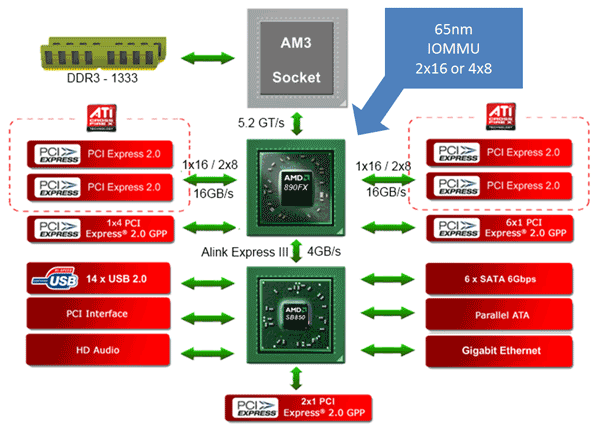AMD's Six-Core Phenom II X6 1090T & 1055T Reviewed
by Anand Lal Shimpi on April 27, 2010 12:26 AM EST- Posted in
- CPUs
- AMD
- Phenom II X6
AMD’s 890FX Chipset
The Phenom II X6 will work in all existing Socket-AM2+ and AM3 motherboards that can 1) support the 125W TDP of the processors, and 2) have BIOS support (apparently over 160 boards at launch). Despite this impressive showing of backwards compatibility, we also get a new chipset today for those of you looking to build a new system instead of upgrade.

The 890FX is a mildly updated version of AMD’s 790FX chipset, mostly adding AMD’s SB850 South Bridge with 6Gbps SATA support. The number of PCIe 2.0 lanes and other major features remains unchanged.
| AMD 890FX | AMD 890GX | AMD 790FX | |
| CPU | AMD Socket-AM3 | AMD Socket-AM3 | AMD Socket-AM3/AM2+ |
| Manufacturing Process | 65nm | 55nm | 65nm |
| PCI Express | 44 PCIe 2.0 lanes | 24 PCIe 2.0 lanes | 44 PCIe 2.0 lanes |
| Graphics | N/A | Radeon HD 4290 (DirectX 10.1) | N/A |
| South Bridge | SB850 | SB850 | SB750 |
| USB | 14 USB 2.0 ports | 14 USB 2.0 ports | 12 USB 2.0 ports |
| SATA | 6 SATA 6Gbps ports | 6 SATA 6Gbps ports | 6 SATA 3Gbps ports |
| IOMMU | 1.2 | N/A | N/A |
| Max TDP | 19.6W | 25W | 19.6W |
You get IOMMU support (an advantage over 790FX) and despite the chipset being built on TSMC's 65nm process, it pulls less power than the 890GX as it lacks any integrated graphics.
The Test
To keep the review length manageable we're presenting a subset of our results here. For all benchmark results and even more comparisons be sure to use our performance comparison tool: Bench.
| Motherboard: | ASUS P7H57DV- EVO (Intel H57) Intel DP55KG (Intel P55) Intel DX58SO (Intel X58) Intel DX48BT2 (Intel X48) Gigabyte GA-MA790FX-UD5P (AMD 790FX) MSI 890FXA-GD70 (AMD 890FX) |
| Chipset Drivers: | Intel 9.1.1.1015 (Intel) AMD Catalyst 8.12 |
| Hard Disk: | Intel X25-M SSD (80GB) |
| Memory: | Corsair DDR3-1333 4 x 1GB (7-7-7-20) Corsair DDR3-1333 2 x 2GB (7-7-7-20) |
| Video Card: | eVGA GeForce GTX 280 (Vista 64) ATI Radeon HD 5870 (Windows 7) |
| Video Drivers: | ATI Catalyst 9.12 (Windows 7) NVIDIA ForceWare 180.43 (Vista64) NVIDIA ForceWare 178.24 (Vista32) |
| Desktop Resolution: | 1920 x 1200 |
| OS: | Windows Vista Ultimate 32-bit (for SYSMark) Windows Vista Ultimate 64-bit Windows 7 x64 |










168 Comments
View All Comments
Scali - Wednesday, April 28, 2010 - link
I think people buying an Extreme Edition CPU know exactly what they're getting themselves into.Those CPUs are never good price/performance, you pay a premium to get the absolute fastest CPU on the market, that's the whole point of the Extreme Edition concept.
Obviously Intel isn't going to offer only one expensive 32nm six-core forever. Perhaps this X6 CPU will trigger Intel to release more 'mainstream' six-cores and other 32nm CPUs.
JGabriel - Tuesday, April 27, 2010 - link
For home use, yes. For professional use, that 48.8 frames/second on the 980x vs. 28.5 on the 1090T, for x264 2nd pass encoding, looks quite justifiable. If that's your business, that'll pay for itself in a couple of weeks..
pjconoso - Tuesday, April 27, 2010 - link
Point taken. I was speaking for home users. ;)pow123 - Wednesday, May 5, 2010 - link
Exactly. A few seconds. I will not pay for an over priced processor for a few seconds. Keep it coming AMD.Lolimaster - Tuesday, April 27, 2010 - link
Watch tom's reviewhttp://www.tomshardware.com/reviews/amd-phenom-ii-...
More justice to the AMD cpu's. Just pass the synthetic intel compiler bugged benchmarks.
haplo602 - Tuesday, April 27, 2010 - link
Actualy the results are what I expected and what was also explained in the review. Not stellar, but very good for the money spent ...I guess I'll buy one of the 4-cores.
Hacp - Tuesday, April 27, 2010 - link
Anand, why do you not try to push the chip on overclocking? Also, why not do an I7 overclocked vs Phenom X6 overclocked performance comparison? Overall, I feel that this review was pretty limited and unenthusiastic for such an exciting product.ymetushe - Tuesday, April 27, 2010 - link
Second this. I was really hoping you'd do some overclocked benchmarks, say at 4GHz, so that we could see clock for clock performance of 6 Thuban cores vs. 8 Bloomfield/Lynfield threads.JGabriel - Tuesday, April 27, 2010 - link
Check the x264 and Cinebench results. Clock for clock, at 2.8 Ghz, two hyper-threaded Lynnfield cores seems to match three Thuban cores - at least for rendering & encoding purposes..
Anand Lal Shimpi - Tuesday, April 27, 2010 - link
I try to provide a look at what sort of headroom you can get out of the chip while feeding it as little voltage as possible. The idea is to keep power consumption at a minimum while increasing performance. I found that the jump from 3.8 to 3.9GHz required quite a bit of additional voltage, while just going to 3.8GHz was basically a non-issue - which to me is more impressive than trying to squeeze another 100 - 200MHz out of the chip.Take care,
Anand